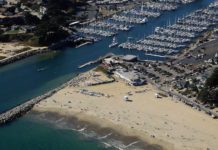Active wildfires in Northern California have already reached historic proportions and continue to burn. Fires around the state, most of which started after thousands of lightning strikes hit the state on August 16th and 17th, have burned over 1.25 millions acres and both the SCU Lightning Complex and the LNU Lightning Complex rank among the state’s five largest wildfires in modern history. Locally, the CZU Lightning Complex has burned over 81,000 acres, destroyed more than 600 structures, and is 21% contained as of August 27th. The size and number of wildfires all burning concurrently have put immense strain on CAL FIRE’s limited resources. According to CAL FIRE Deputy Chief Jonathan Cox 96% of CAL FIRE’s resources are currently engaged in fighting active fires and more resources are needed. Cox serves as the line officer on the CZU Lightning Complex incident. CAL FIRE’s success in fighting the current siege of fires around the state relies on its ability to cooperate with countless supporting agencies around the state and across the country. California’s mutual aid system is the bedrock of this cooperative effort.
Governor Newsom signed a declaration of a state of emergency on August 18th. The declaration allows for the efficient reallocation of resources to emergencies by utilizing California’s mutual aid system. Newsom spoke about this at his August 24th press briefing and said, “We have in-state mutual aid which is just mesmerizing and a point of deep pride.” The governor’s office shared that as of August 24th 2,827 firefighters and 709 engines have been reallocated using the in-state mutual aid system. Cox echoed the governor’s point while noting that the historic nature of this moment has put stress even on California’s well-established system of mutual aid and explained that some delay in receiving resources is due to the finite bandwidth that those resources have to flow through. Newsom’s proclamation also activated the California National Guard, which has a strong partnership with CAL FIRE and a history of supporting CAL FIRE’s firefighters.
The California National Guard deployed its first task force, Task Force 203, on Wednesday to the LNU Lightning Complex. According to Lieutenant Colonel David Chang, Task Force 203 comprises several army units with approximately three hundred soldiers in total. Chang, a battalion chief for one of the units in Task Force 203, also said due to the severity of the wildfires across the state a second task force at Camp Roberts and will leave for active wildfire incidents next week after they complete their CAL FIRE training. The National Guard task forces represent much-needed additional personnel. CAL FIRE Incident Commander for the CZU Lightning Complex Billy See said the National Guard will support CAL FIRE’s effort in Sonoma County, which will free up more experienced firefighters to leave the LNU Lightning Complex to help fight the CZU Lightning Complex instead. The more experienced firefighters coming from Sonoma are more prepared for the difficult terrain of the Santa Cruz Mountains and for the variety of firefighting techniques being used to protect Bonny Doon and the towns along the Highway 9 corridor such as Boulder Creek, Ben Lomond, and Felton. CAL FIRE Battalion Chief Mark Brunton explained how the CZU Lightning Complex has challenged CAL FIRE and has required firefighters to use a variety of techniques to constantly make small wins. Some of the techniques include herding fire around population areas, bump and run to save individual structures, and burn out operations to reduce the amount of available fuel. CAL FIRE Chief Dan Olson serves as the incident’s public information officer and has explained how the cooperative sharing of resources between the incident commanders is similar to horse trading and allows CAL FIRE to utilize each resource available to its maximum potential.
While more experienced Type I firefighters come to complete missions on the CZU Lightning Complex, California National Guard hand crews will help support CAL FIRE’s efforts containing the LNU Lightning Complex. CAL FIRE Captain Sean Sunahara oversaw the training of Task Force 203 at Camp Roberts and explained, “One of the benefits about using the National Guard is they already have that mental toughness…they know how to be professionals and they already know how to act in this type of environment.” CAL FIRE has designed a special five day firefighting training to supplement the basic training National Guard soldiers receive. This supplemental training has deepened the partnership between the California National Guard and CAL FIRE over the last five years that it has existed. According to Private Second Class Cynthia Portillo the classroom portion of training includes wildfire safety, the effects of weather on fire behavior, and analyzing scenarios from past wildfires while the hands-on field training includes cutting line, hose manipulation, mopping up burn areas, and putting out hot spots. She also highlighted the importance of safety on the fire line and how in the training they learn to use eye contact and constant communication to ensure everyone’s safety while working in dangerous situations. Although the National Guard troops are trained, Sunahara explained they always have firefighter support when they go out on the line and are only put into situations that they are set up for success in. The long-standing partnership between CAL FIRE and the California National Guard goes to show the importance of cooperation in times of crisis and the value of California’s mutual aid system.
Nick Morris lives in Santa Cruz, but enjoys spending time in the San Lorenzo Valley. He attended SF State and enjoys filmmaking and tutoring. Contact him at ni*************@***oo.com.
Additional Sources:
● https://www.youtube.com/watch?v=-saNnA20YmA
● https://www.gov.ca.gov/wp-content/uploads/2020/08/8.18.20-Fire-State-of-Emergency-Proclamation.pdf
● https://www.fire.ca.gov/incidents/












